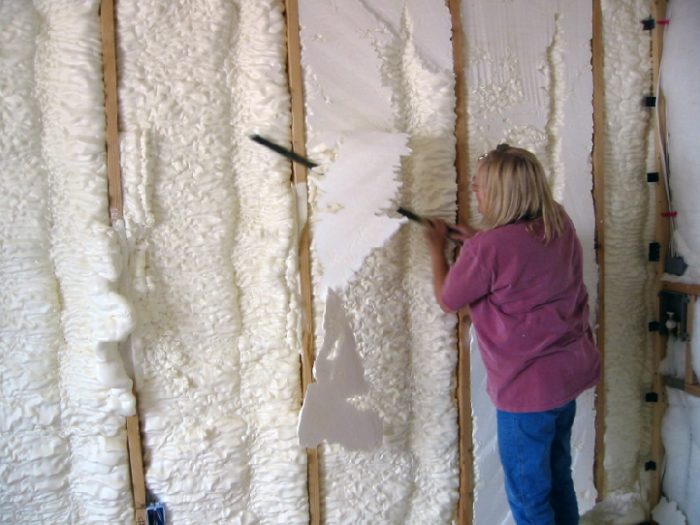Is There a Downside to Spray Foam Insulation? 2024
As a home builder, you're aware of how insulation choices impact a building's energy use, strength, and the safety it offers. Each type of insulation has its good and bad points. Spray foam insulation, made from polyurethane, is extremely airtight. This is true when it's applied perfectly in a steady, unbroken layer. Yet, using spray foam insulation in houses has serious disadvantages. These include risks like moisture and mold growth, peculiar smells, serious moisture-caused damage, even termite threats, and needed ventilation concerns.
It's crucial for homeowners to be well-informed about the potential downsides of spray foam insulation. This knowledge empowers them to consider these factors when selecting the most suitable insulation solution for their home.

Key Takeaways
- Spray foam insulation can lead to moisture and mold issues, especially with closed-cell foam.
- Improper installation can result in foul odors and off-gassing, forcing homeowners to evacuate.
- Spray foam can hide areas where termites and pests can get in, making it harder to detect infestations.
- Extreme airtightness from spray foam can cause ventilation problems, leading to issues like superheating and carbon monoxide poisoning.
Understanding Spray Foam Insulation
Spray foam insulation is made of materials like polyurethane. It's great at sealing small gaps in your home, making it very airtight. It helps keep your home cool in the summer and warm in the winter, saving you money on your energy bill.
Types of Spray Foam Insulation
There are two main types of spray foam insulation: open-cell and closed-cell foam. Open-cell foam has an R-value of about 3.5 per inch. It's more flexible. Closed-cell foam has a higher R-value, about 6 to 7 per inch. It's stiffer and better at keeping out moisture.
Open-Cell vs. Closed-Cell Foam
Closed-cell spray foam has a better R-value than open-cell spray foam. It blocks more moisture and is stronger. However, open-cell foam is more flexible but shouldn't get wet. Assess your needs to pick the right one for your home.
| Property | Open-Cell SPF | Closed-Cell SPF |
|---|---|---|
| R-value (per inch) | ~3.5 | >6.0 |
| Moisture Barrier | More permeable | Higher moisture barrier |
| Strength and Rigidity | Lower | Higher |
| Water Resistance | Not recommended for direct contact | Resists water |
| Density (lbs./ft³) | 0.4 to 1.2 | 1.75 to 2.25 |
Advantages of Spray Foam Insulation
Close Cell insulation kit is great for keeping your home airtight and efficient. It lowers heating and cooling costs. Plus, it makes your house more comfortable all year round.

Potential Problems with Spray Foam Insulation
Spray foam insulation can be a great choice for keeping your home energy-efficient. But it's important to know about the downside, too. The team at VB Insulation knows a lot about spray foam and has seen issues that can happen when installing it.
Moisture and Mold Issues
With spray foam, moisture, and mold are big concerns. Serious moisture can get trapped behind it, causing mold to grow. Mold is not only bad for your home but also your health. It can even be expensive to fix once it starts.
Odor and Off-Gassing Concerns
When spray foam is not mixed right, it can smell bad. Some homes have smelled so bad that people had to leave. These smells can seriously affect the health and happiness of people living in the home.
Termite and Pest Problems
Spray foam can hide spaces where pests like termites can get into your home. It makes it hard for inspectors to see if there's an infestation. This could mean your house gets damaged a lot before you even know there's a problem.
Airtightness and Ventilation Requirements
While spray foam keeps the air inside, it can also keep bad air in. If your ventilation system isn't good, this can make the indoor air dangerous. It's important to make sure your ventilation is working well if you have spray foam.

Spray foam insulation Alternatives.
While efficient spray foam insulation can sometimes pose problems, however, there are reassuring alternatives. Cotton denim insulation, for instance, is eco-friendly, fights off mold and bugs, and offers good insulation. Cellulose insulation, also from recycled materials, allows for easy inspections and better air circulation than spray foam.
Cotton Denim Insulation
Cotton denim insulation is a green choice that keeps buildings quiet and warm. Using old scraps, it's safe from mold, bugs, and more. This makes it a top pick for places where people live or work.
Cellulose Insulation
Cellulose insulation comes from recycled items, like paper. It doesn't keep heat as well as spray foam but deals with moisture better. It can be taken out for inspections easily. Cellulose is also treated with safe flame retardants, which is good for the environment.
Read More: Cost of Spray Foam Insulation
Proper Installation and Maintenance
The effectiveness and safety of spray foam insulation hinges on proper installation and ongoing care. Homeowners play a crucial role in this. By hiring professional insulation contractors and conducting regular inspections, they can ensure the correct application and early detection of any issues, such as mold growth, odor problems, and airtightness concerns.
Hiring Professional Contractors
When it comes to the installation of spray foam insulation, the role of professional contractors cannot be overstated. Contractors from a reputable company like VB Insulation possess the necessary tools and expertise to ensure a correct application, thereby safeguarding your home from potential issues like mold growth and odor problems.
Importance of Proper Ventilation
A good ventilation system is key when using spray foam insulation. If not ventilated well, it can cause superheating and carbon monoxide build-up. So, the right ventilation, like energy recovery or passive choices, is vital for indoor air quality and safety.
Regular Inspections and Maintenance
Keep checking your spray foam-insulated home even after it's installed. Look for moisture, mold, or pests regularly to catch problems early. Also, make sure your ventilation system is working and fix any spray foam issues to keep your home efficient and safe.
Read More: How to Install Spray Foam Insulation? Step by Step Guide
Conclusion
Spray foam insulation can make your home more energy-efficient and comfortable. Yet, it has some downsides. Homeowners should be aware of possible issues like moisture, mold, and pests. If not installed correctly, spray foam can cause odor, off-gassing, and airtightness worries.
When choosing home insulation, think about the pros and cons. Also, rely on professional insulation contractors for the right installation and upkeep. This approach helps you pick the best option for your home. It ensures your home is more energy efficient and has better indoor air quality.
VB Insulation is here to help. We offer top-notch, eco-friendly building materials for improved energy use and health. Our experts will help select and install the best insulation for your needs and climate. Contact us to find out more about our insulation alternatives. Let us assist you in reaching your home's energy goals.
FAQ
What are the potential downsides of using spray foam insulation in homes?
Spray foam insulation can have downsides. These include problems with moisture and mold, odors, and off-gassing. Another issue is that it can lead to problems with termites and pests. It needs to be installed while considering airtightness and ventilation.
What are the different types of spray foam insulation?
There are two main types of spray foam insulation: open-cell and closed-cell foam. Each type has different abilities for keeping heat in, stopping dampness, and dealing with moisture.
What are the key advantages of using spray foam insulation?
Spray foam insulation has several key benefits. It seals air leaks, making homes more energy efficient. It also helps prevent moisture and maintain consistent temperatures.
What are some of the moisture and mold issues associated with spray foam insulation?
Sometimes, spray foam insulation can lead to mold problems. This is more likely with closed-cell foam. It can trap moisture and provide a good place for mold to grow.
Can spray foam insulation lead to odor and off-gassing problems in homes?
Improper spray foam installation can cause bad smells and fumes. Due to the strong and hard-to-bear odors, homeowners might have to leave their homes for a while.
How can spray foam insulation impact termite and pest infestations?
Spray foam insulation can offer hiding spots to termites and pests, making it harder to spot infestations early on.
What ventilation concerns come with the airtightness of spray foam insulation?
If not installed properly, the airtightness of spray foam can cause problems. These might include overheating, carbon monoxide issues, and damage to the roof. These problems arise if the house's ventilation system needs to be up to the task.
What are some alternative insulation options to spray foam that homeowners can consider?
Homeowners can consider other insulation materials, such as cotton denim, cellulose, and HempWool®. These alternatives offer energy-efficient benefits without the issues associated with spray foam.
Why is it important to hire professional contractors for spray foam insulation installation?
Professional contractors are essential for installing spray foam. They ensure the job is done right. Improper installation, like wrong chemical mixes or overlooking details, can cause problems. These problems include mold, bad smells, and airtightness issues.



